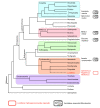Anaerobic animals from an ancient, anoxic ecological niche
- PMID: 20370917
- PMCID: PMC2859860
- DOI: 10.1186/1741-7007-8-32
Anaerobic animals from an ancient, anoxic ecological niche
Abstract
Tiny marine animals that complete their life cycle in the total absence of light and oxygen are reported by Roberto Danovaro and colleagues in this issue of BMC Biology. These fascinating animals are new members of the phylum Loricifera and possess mitochondria that in electron micrographs look very much like hydrogenosomes, the H2-producing mitochondria found among several unicellular eukaryotic lineages. The discovery of metazoan life in a permanently anoxic and sulphidic environment provides a glimpse of what a good part of Earth's past ecology might have been like in 'Canfield oceans', before the rise of deep marine oxygen levels and the appearance of the first large animals in the fossil record roughly 550-600 million years ago. The findings underscore the evolutionary significance of anaerobic deep sea environments and the anaerobic lifestyle among mitochondrion-bearing cells. They also testify that a fuller understanding of eukaryotic and metazoan evolution will come from the study of modern anoxic and hypoxic habitats.
Figures


Comment on
-
The first metazoa living in permanently anoxic conditions.BMC Biol. 2010 Apr 6;8:30. doi: 10.1186/1741-7007-8-30. BMC Biol. 2010. PMID: 20370908 Free PMC article.
Similar articles
-
Anaerobic metazoans: no longer an oxymoron.BMC Biol. 2010 Apr 6;8:31. doi: 10.1186/1741-7007-8-31. BMC Biol. 2010. PMID: 20370909 Free PMC article.
-
The first metazoa living in permanently anoxic conditions.BMC Biol. 2010 Apr 6;8:30. doi: 10.1186/1741-7007-8-30. BMC Biol. 2010. PMID: 20370908 Free PMC article.
-
The challenge of proving the existence of metazoan life in permanently anoxic deep-sea sediments.BMC Biol. 2016 Jun 7;14:43. doi: 10.1186/s12915-016-0263-4. BMC Biol. 2016. PMID: 27267928 Free PMC article.
-
Energy metabolism among eukaryotic anaerobes in light of Proterozoic ocean chemistry.Philos Trans R Soc Lond B Biol Sci. 2008 Aug 27;363(1504):2717-29. doi: 10.1098/rstb.2008.0031. Philos Trans R Soc Lond B Biol Sci. 2008. PMID: 18468979 Free PMC article. Review.
-
Evolution and biogeography of deep-sea vent and seep invertebrates.Science. 2002 Feb 15;295(5558):1253-7. doi: 10.1126/science.1067361. Science. 2002. PMID: 11847331 Review.
Cited by
-
Evolution of air breathing: oxygen homeostasis and the transitions from water to land and sky.Compr Physiol. 2013 Apr;3(2):849-915. doi: 10.1002/cphy.c120003. Compr Physiol. 2013. PMID: 23720333 Free PMC article. Review.
-
Biochemistry and evolution of anaerobic energy metabolism in eukaryotes.Microbiol Mol Biol Rev. 2012 Jun;76(2):444-95. doi: 10.1128/MMBR.05024-11. Microbiol Mol Biol Rev. 2012. PMID: 22688819 Free PMC article. Review.
-
Mitochondrial adaptations to utilize hydrogen sulfide for energy and signaling.J Comp Physiol B. 2012 Oct;182(7):881-97. doi: 10.1007/s00360-012-0654-y. Epub 2012 Mar 20. J Comp Physiol B. 2012. PMID: 22430869 Review.
-
Metagenomic 18S rDNA reads revealed zonation of eukaryotic communities in the Yongle blue hole.Front Microbiol. 2024 Jul 29;15:1420899. doi: 10.3389/fmicb.2024.1420899. eCollection 2024. Front Microbiol. 2024. PMID: 39135873 Free PMC article.
-
Photosynthesis in hydrogen-dominated atmospheres.Life (Basel). 2014 Nov 18;4(4):716-44. doi: 10.3390/life4040716. Life (Basel). 2014. PMID: 25411926 Free PMC article.
References
-
- Yakimov MM, La Cono V, Denaro R, D'Auria G, Decembrini F, Timmis KN, Golyshin PN, Giuliano L. Primary producing prokaryotic communities of brine, interface and seawater above the halocline of deep anoxic lake L'Atalante, Eastern Mediterranean Sea. ISME J. 2007;1:743–755. doi: 10.1038/ismej.2007.83. - DOI - PubMed
Publication types
MeSH terms
Substances
LinkOut - more resources
Full Text Sources
Miscellaneous

